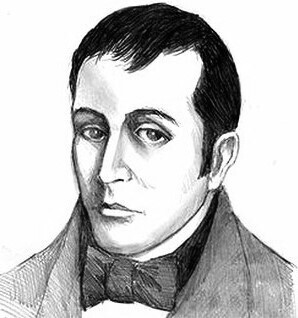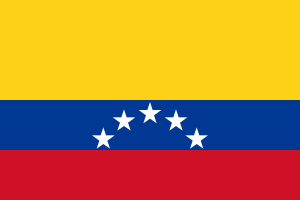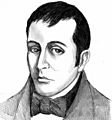José Núñez de Cáceres facts for kids
Quick facts for kids
José Núñez de Cáceres
|
|
|---|---|
 |
|
| President of the Republic of Spanish Haiti | |
| In office December 1, 1821 – February 9, 1822 |
|
| Personal details | |
| Born | March 14, 1772 Santo Domingo, Captaincy General of Santo Domingo (now Dominican Republic) |
| Died | September 11, 1846 (aged 74) Ciudad Victoria, Tamaulipas, Mexico |
| Nationality | Spanish (until 1821), Dominican and Venezuelan (1821–1846) |
| Spouse | Juana de Mata Madrigal Cordero |
| Children | Pedro, José, Francisco de Asis, Gerónimo, Gregorio, and Maria de la Merced. |
| Residences | Santo Domingo, Venezuela, Mexico |
| Profession | Politician and writer |
| Military service | |
| Allegiance | |
José Núñez de Cáceres y Albor (born March 14, 1772 – died September 11, 1846) was an important Dominican politician and writer. He is famous for leading the fight for independence from Spain in 1821. He was also the only president of the very short-lived Republic of Spanish Haiti. This country existed for only a few months, from December 1, 1821, to February 9, 1822. Because it lasted such a short time, this period is often called the "ephemeral independence." It ended when the island of Hispaniola was united under the Haitian government.
Before independence, Spain didn't pay much attention to the eastern part of Hispaniola. During this time, Núñez de Cáceres was a pioneer in using writing to protest against colonial rule. He was also the first Dominican writer of fables (short stories with a moral). Many of his writings appeared in his own funny newspaper, El Duende. This was only the second newspaper ever created in Santo Domingo.
Contents
Early Life and Education
José Núñez de Cáceres Albor was born on March 14, 1772, in Santo Domingo. His father was Francisco Núñez de Cáceres, and his mother was María Albor Polanco. Sadly, his mother died just a few days after he was born. He had two older brothers, Pedro and Gerónimo. His aunt, María Núñez de Cáceres, raised him.
From a young age, José loved learning. However, his father was a farmer and wanted José to work in the fields. His family was very poor, so José had to borrow books from his classmates to study. He also earned a little money by helping his aunt sell doves. Despite these challenges, Núñez de Cáceres finished his law studies at age 23 in 1795. After that, he worked as a lawyer for important people. He also became a professor at the University of Santo Tomás de Aquino.
Political Journey
In 1799, the colony of Santo Domingo was given to France by the Treaty of Basel. The main court, called the Audiencia Real, moved from Santo Domingo to Puerto Príncipe (now Camagüey) in Cuba. Núñez de Cáceres and his family moved with it. In August 1800, he was appointed to a legal position there. He was still able to practice law.
Núñez de Cáceres also advised the Cuban government. In late 1808, Spain took back control of Santo Domingo. He then returned home. He wrote a famous song to honor the winners of the Battle of Palo Hincado. From 1810 to 1813, he worked for Juan Sánchez Ramírez, who was the governor. He held important legal and government roles in Santo Domingo. In 1812, to help the weak economy, Núñez de Cáceres ordered the use of paper money. He also put in place emergency economic plans.
Núñez de Cáceres had disagreements with Lieutenant José Álvarez de Toledo. Álvarez de Toledo had revolutionary ideas. Núñez de Cáceres, who was then president of the Cortes (a type of parliament), reported these ideas. The Cortes decided to take legal action against Álvarez de Toledo, but he could not be found.
Around 1812, Núñez de Cáceres started to change his mind about colonies in Spanish America. He began to think they should be independent.
His new ideas made him an enemy of the authorities in Santo Domingo. This was especially true for Governor Sánchez Ramírez. After Sánchez Ramírez died, Núñez de Cáceres tried to get a job on a court in Ecuador. But most court members said no. This led him to lead an independence movement. He wanted the colony to become a protectorate (a country protected by a stronger one) of Simón Bolivar's Gran Colombia.
The Fight for Independence
Núñez de Cáceres wanted independence from Spain. He also wanted his country to join Gran Colombia. He tried to separate his country from Spain in the spring of 1821. This was a secret plan, but it failed. The governor took action, and Núñez de Cáceres's group didn't get a reply from Simón Bolívar in time. Even after the plot was known, the governor still let Núñez de Cáceres prosecute a captain for writing bad things about him.
A new Spanish governor, Pascual Real, arrived in May 1821. He believed the people who reported Núñez de Cáceres's secret plans. He also quickly learned the names of Núñez de Cáceres's supporters. However, Governor Real had no soldiers. So, he watched the suspects and tried to win over important military leaders. Meanwhile, a group who favored Haiti learned about Núñez de Cáceres's plans. They explained the situation to Haitian President Jean-Pierre Boyer. They wanted the former Spanish colony to join Haiti.
On November 8, Major Andrew Amarante announced the start of Haiti's annexation in Beler. Seven days later, on November 15, this spread to Dajabón and Monte Cristi. On the same day, the "Constitutive Act of Independence" was announced. This act set out the rules for the new government. It also stated the new government's goal to be a part of Gran Colombia. But it still wanted the country to be independent.
The movement for independence began on November 30, 1821. The next month, on December 30, soldiers attacked the fortress. They trapped the governor inside. At dawn, the creation of the Independent State of Spanish Haiti was announced. The rebels then read the Dominican Declaration of Independence. Núñez de Cáceres and several others wrote it. Núñez de Cáceres set up a temporary government and became its President. He also created a Constitution. This constitution allowed slavery, even though it was becoming unpopular at the time.
To stop an invasion from neighboring Haiti, Núñez de Cáceres sent Antonio María Pineda to Venezuela. Pineda was to tell Simon Bolívar about the situation. But Bolívar was not in Caracas. Neither the vice president nor the general in charge of the city paid attention to Pineda.
Haitian Unification
Around the same time the Independent State of Spanish Haiti was declared, three people sent by President Boyer arrived in Santo Domingo. They were ordered to report on Governor Pascual Real's actions. They also observed the situation in Dajabón and Monte Cristi. Colonel Fremont, the Haitian leader of the group, learned about the new government. He told Núñez de Cáceres that President Boyer would support it.
However, Haiti's real goal was to invade the eastern part of the island. They wanted to unite the whole island under Haitian rule. Núñez de Cáceres did not get the support he hoped for from Gran Colombia. On January 11, 1822, Boyer wrote to Núñez de Cáceres. He said he planned to visit the eastern part of Spanish Haiti with an army. He said he was coming as a peacemaker, not an invader. But he also warned Núñez de Cáceres not to create any problems.
When Núñez de Cáceres read Boyer's message, he knew joining Gran Colombia was impossible. Most of the important Dominican people and military leaders preferred to join Haiti. So, he had no choice but to agree to Boyer's demands. He allowed the city to be placed under Haitian control. Seven days later, on January 19, Núñez de Cáceres himself took down the Colombian flag in the capital. He replaced it with the Haitian flag. On February 9, 1822, he gave the keys to the city of Santo Domingo to President Boyer.
In August, Núñez de Cáceres was still in Santo Domingo. He was secretly trying to get support from Gran Colombia. Boyer found out about his activities. He demanded that Núñez de Cáceres leave the island. Boyer said his presence was causing problems. He warned that if Núñez de Cáceres didn't leave willingly, force would be used. However, Boyer also gave him a lifelong payment to help him.
Later Years
In April 1823, Núñez de Cáceres and his family moved to Venezuela. They settled in Maracaibo. In 1824, he started working as a printer in Caracas. Later, he started several newspapers that criticized Gran Colombia. These included El Constitucional Caraqueño (1824-1825), El Cometa (1824-1826), and El Cometa Extraordinario (1826-1827). He also wrote the last issues of El Venezolano (1823-1824). He joined a movement called La Cosiata, which rebelled against Gran Colombia.
On May 5, 1826, Caracas decided to join the revolution led by José Antonio Páez. José Núñez de Cáceres and Pedro Pablo Diaz were chosen to advise Páez. In 1827, Páez made de Cáceres his secretary and advisor. Because of his position, de Cáceres helped Venezuela break away from Gran Colombia. However, this led to him being put in prison in Maracaibo for a short time. Bolívar moved de Cáceres away from Caracas. He suggested de Cáceres become the president of a court in Cumaná. But de Cáceres refused. He decided to move to Mexico with his family.
José Núñez de Cáceres arrived in Mexico in April 1827. They first lived in Puebla. Then they moved to Ciudad Victoria in Tamaulipas. In his early years there, he worked as a lawyer. In 1830, he became a prosecutor for the supreme court. In 1833, he became a senator for Tamaulipas and a member of the Mexican Confederation Congress. He was recognized as a "Distinguished Citizen of Tamaulipas."
He worked with General Moctezuma and supported his plans. In 1834, he became the treasurer of Public Finance. He still continued to work as a lawyer.
By 1844, he became very ill. The government of Tamaulipas gave him a pension to help him. He died in Ciudad Victoria, Tamaulipas, on September 11, 1846. His remains are now in the National Pantheon of the Dominican Republic in Santo Domingo.
Literary Works
José Núñez de Cáceres was also an important writer and teacher. He became a professor at the University of Santo Tomás de Aquino in 1795. On January 6, 1815, he returned to teaching at the University of Santo Domingo. Because of his efforts, he was appointed as the first leader (rector) of the university. His portrait was placed in the lecture hall, paid for by the university group.
On April 15, 1821, José Núñez de Cáceres started the funny and political newspaper El Duende in Santo Domingo. This was the second newspaper ever published in the Dominican Republic. El Duende came out every Sunday in the capital. It ran for thirteen issues but stopped on July 15 of that year. Núñez de Cáceres published his first nine fables in this newspaper. He also started another newspaper called El Relámpago (Lightning) in the same city.
In Venezuela, Núñez de Cáceres started several other newspapers. These included El Constitucional Caraqueño (The Constitutional from Caracas) and La Cometa (The Comet). La Cometa strongly criticized Simón Bolívar. He also wrote for El Cometa Extraordinario and the last issues of El Venezolano. In Venezuela, he continued to write fables.
He wrote twelve fables in total. Some of them are "el conejo" (the rabbit), "la oveja y el lobo" (the sheep and the wolf), "el lobo y el zorro" (the wolf and the fox), "la araña y el águila" (the spider and the eagle), and "la aveja y abejorros" (the bee and bumble). He signed these fables with the pen name "El fabulista principiante" (The fabulist beginner). He is known as the first Dominican writer of fables and one of the first storytellers in Spanish America.
Núñez de Cáceres was very well-read. He knew the works of famous fable writers like Aesop, Phaedrus, Jean de La Fontaine, Samaniego, and Tomás de Iriarte. They influenced his writing, especially his use of animals as characters. For example, out of the nineteen characters in his eleven fables, many are also found in the works of these classic writers.
Family Life
In the late 1700s, Núñez de Cáceres married Juana de Mata Madrigal Cordero. They had six children between 1800 and 1816. Three of their children were born in Camagüey, Cuba.
After de Cáceres died, his student, Simon de Portes, gave a speech at his funeral. He spoke about how Núñez de Cáceres was happy to hear that the people of Santo Domingo had driven out their oppressors.
See also
 In Spanish: José Núñez de Cáceres para niños
In Spanish: José Núñez de Cáceres para niños
- History of the Dominican Republic
- Captaincy General of Santo Domingo
- Era de Francia
- España Boba
- Republic of Spanish Haiti
- Haitian occupation of Santo Domingo
- La Trinitaria
- Juan Sánchez Ramírez
- Juan Pablo Duarte
- Francisco del Rosario Sánchez
- Matías Ramón Mella
Images for kids



